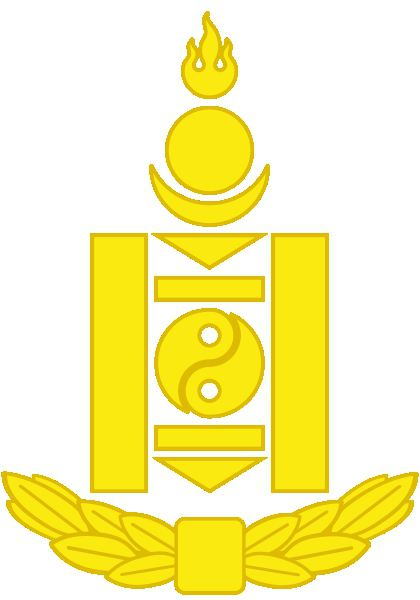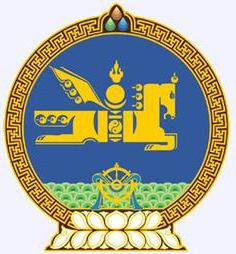Coat of arms of Mongolia. Mongolia flag - description, symbols, history, colors, photos

Attention! contacts have changed: our phone: 986-51-71
Description
The national flag of Mongolia is a rectangular banner divided into three equal vertical stripes. Side stripes are colored red, the central - in blue. On the red strip adjacent to the pole, yellow state symbol Mongolia "Soyombo".
Symbolism
The blue bar indicates the cloudless sky of Mongolia, the red one indicates the fires of bonfires in the steppe and the blood shed during the struggle for the independence of the state. A golden yellow hue indicates stability and prosperity. The interpretation of Soyombo is related to the ancient totems of the Mongolian people and Indo-Buddhist philosophical teachings. The small signs that make up the symbol denote whole concepts (rebirth, eternity, justice, courage). Of particular interest is the image of the sign "Anusvara", which is a semicircle with three flames of flame. According to Buddhist philosophy, "anusvara" symbolizes the point from which the universe began to develop.
Story
Official status national flag The Mongolian flag received in 1992. The previous version of the flag differed from the current image of the pentagram designating the North Star (a symbol of socialism).
In our company you can order the manufacture of flags of Mongolia, as well as purchase or for them. Possible circulations, prices and terms of production are indicated in the section, check with our company managers for more information.
If you ask a modern Russian resident what the coat of arms of Mongolia or its flag looks like, or what country the country is following, then not everyone can answer. The only thing that can be remembered is that in Soviet times there was a Mongolian people's republic that chose socialism.
Milestones in History
The oldest coat of arms in these territories existed during the time of the state of Hunnu and was a golden sun and a golden crescent. The story is silent about the remaining characters. But the twentieth century in Mongolia is characterized by frequent and cardinal changes of the country's main symbols:
- soembo sign, a symbol of prosperity (1911-1939);
- the same sign plus the lotus branch - a symbol of victory on Halkin-Gol (1939-1940);
- arath horseman jumping to sunrise (1940-1992).
National symbols on the modern coat of arms
The main emblem of Mongolia appeared not so long ago, in 1992, and marked the beginning of a new stage in the life of the country after the disappearance of the MPR. The new main symbol of the country reflects ancient signs filled with deep meaning and primary colors.
The emblem is located on the background of the azure circle, the color, of course, means sky. Along the contour of the circle is a golden color pattern, which is called "Tumen Nusan", symbolizes the unity of the Mongolian nation. The central place on the Mongolian coat of arms is occupied by the stylized figure of the stallion, which is also the national emblem of Soembo. Since ancient times, the horse for the Mongol is a friend, helper, savior, breadwinner. Therefore, the image of this animal symbolizes the independence of Mongolia, its right to sovereignty and free choice of development path.
In addition, other important signs and talismans are located on the modern coat of arms of Mongolia. For example, in the upper part there was a place for “chintamani” - a talisman that can fulfill wishes, it simultaneously designates the past, present, and future.
Many Russians consider Mongolia a plain territory, almost a continuous desert. But there are also mountains in which the locals are very proud. That is why they placed them on the coat of arms, in its lower part. Here is another important symbol - the wheel (dharmachakra), which refers to the Buddhist religion, which is professed by a large part of the country's population. A ritual scarf, the so-called hadak, wraps around this wheel.
Each country has its own symbolism, which reflects the ideas of the people, their policies and individuality. Mongolia is no exception. The emblem and flag, as well as the anthem, are its main legal attributes.
Flag of the country and its meaning
The Mongolian flag was officially approved in 1992. Just then this national symbol turned into an integral attribute of the country.
The flag of Mongolia is divided into three vertical stripes: red at the edges, blue in the middle. On the red stripe flaunts the national symbol of Mongolia - "Soymbo". This is a character from the Mongolian alphabet, which is located on all the main attributes of the state.
The flag of each state always carries some hidden meaning. And what does the flag of Mongolia mean? The red stripes on the flag symbolize the unwavering power of the country, as well as the harsh conditions in which this stubborn and strong-willed people have to live. A blue bar means heaven and hope.
The symbol "soyombo", which adorns the flag of Mongolia, also carries a hidden meaning. Thus, the flame depicted on it is a sign of the wealth and prosperity of the Mongolian people. The flame has three reeds, each of them - past, present and future - suggests that Mongolia has been, is and will be a strong and prosperous country. Also, the sun over a half of the month, which are also part of the symbol "soyombo", also speaks of the eternal existence of this country.
Two triangles with their tops down under rectangular lines represent spears that will defeat enemy troops. In the center of the symbol is the Yin-Yang sign, which embodies the masculine and feminine principles, as well as complete harmony between them. On both sides of this column of characters are long rectangles. These are walls that protect the state, as well as strengthen everything that is inside.

Mongolia flag history
As mentioned above, the flag of Mongolia, existing today, was officially approved in 1992, January 12 - the year when the country embarked on the democratic path of development. Until that time, the country also had standards, but several others.
So, since 1911, when the country was called the Mongolian People’s Republic, the flag of the country was dark red with yellow stripes at the edges. The symbol "soyombo" was also present on it. He was only depicted in the middle of the canvas, and not on the strip extreme to the shaft, as in the modern version.
Since 1940, the flag of Mongolia has already acquired the outlines of the modern: red stripes on the sides and a blue center appeared. The symbol "soyombo" has already moved to the "appropriate place", and above it appeared socialist stars.
Coat of arms of Mongolia
 Like the flag, the coat of arms of Mongolia takes pride of place among the symbols of the country. It is a circle framed by a pattern of versatile swastika, which symbolizes well-being and happiness. At the base of the circle is a white “badam” - the personification of purity, and at the top - “chandaman”, a symbol of the past, present and future. The center of the circle is filled with a blue background, symbolizing the sky, which depicts a golden horse. This animal is sacred to Mongolia. It personifies the sovereignty, freedom and eternal prosperity of the Mongolian state. The symbol "soyombo" is inscribed in the figure of the horse.
Like the flag, the coat of arms of Mongolia takes pride of place among the symbols of the country. It is a circle framed by a pattern of versatile swastika, which symbolizes well-being and happiness. At the base of the circle is a white “badam” - the personification of purity, and at the top - “chandaman”, a symbol of the past, present and future. The center of the circle is filled with a blue background, symbolizing the sky, which depicts a golden horse. This animal is sacred to Mongolia. It personifies the sovereignty, freedom and eternal prosperity of the Mongolian state. The symbol "soyombo" is inscribed in the figure of the horse.
A horse gallops over the land designated This is a Buddhist symbol, which means continuous development, which also speaks of the eternal existence of the Mongolian people.
National anthem
During the twentieth century, Mongolia managed to change three national anthems. So, the first was used from the mid-twenties to 1950. Then for twelve years he was succeeded by the following. And from 1961 until the end of the fall of Soviet power in Mongolia, the third anthem sounded.
After 1991, when democracy reigned in the country, it was decided to return the first anthem, which sounded in the mid-twenties. It was slightly changed: the lines dedicated to Lenin, Stalin, Choibalsan and Suhe-Bator were removed.
In June 2006, on the day dedicated to the eightieth anniversary of the founding of the great, a verse praising Genghis Khan was included in the anthem.
On the flag of Mongolia:
Three vertical stripes of the same width: red, blue and red.
The yellow Soyombo symbol in the center of the red bar, closer to the pole.
The meaning and history of the flag of Mongolia:
The blue color of the flag of Mongolia is the color of the cloudless sky of the country. Red color symbolizes fire, the flame of bonfires in the steppe, reminiscent of the victory of the national liberation revolution in 1921. On the red strip near the shaft there is a golden ideogram, in the upper part of which there is a symbol “soimbo” - the sun, moon and a special sign “annusvara” - the point from which, according to Buddhist teachings, the universe began its development. Three tongues of flame crowning the "annusvara" personify the past, present and future.
The flag of 1949-1992 was distinguished by a five-pointed star, which stood above Soyombo, was interpreted as the North Star and symbolized a socialist orientation. Also, the blue field was painted in a more intense blue color.
The flag of the sample from 1924-1940 consisted of a red cloth with a blue soymbo in the center. Soyombo was erected on a pedestal of lotus petals, adopted for the sculptures of Buddhism, thus emphasizing the sacred status and perfection of the Mongolian state.
The flag of the 1921-1924 model consisted of a red cloth with the sun and moon, which are interpreted as heavenly parents, but are also part of the Indo-Buddhist cultural and religious heritage.
Colors of the flag of Mongolia:
Red, blue, yellow
- The training system according to the Dalton plan - the organization of the educational process - Sergei V. Sidorov
- Internal differences, specialization of individual cities
- Consonant and letter th
- Not a single word: whom to work after philology
- Warning flags on the beach
- Abstract of speech therapy classes in elementary school
- Sound and Alpha Word Analysis

 Live journal
Live journal Facebook
Facebook Twitter
Twitter